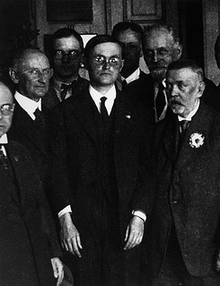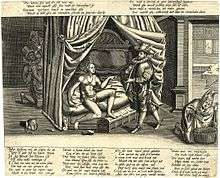Eric Dingwall
| Eric Dingwall | |
|---|---|
 Eric Dingwall (middle) in 1923. | |
| Occupation | Anthropologist, psychical researcher |
Eric John Dingwall (1890–1986) was a British anthropologist and psychical researcher.
Biography
Born in British Ceylon he moved to England where he was educated at Pembroke College, Cambridge (M.A., 1912), and the University of London (D.Sc., PhD).[1] He wrote popular books on sexology.[2] He became interested in paranormal phenomena in 1921 and served from 1922 to 1927 as a research officer for the Society for Psychical Research (SPR).[3]
Dingwall was described as an eccentric by those who had known him.[4] From 1947 he worked as an assistant keeper in the British Museum, cataloguing private case material of erotica.[5] He co-edited the four-volume set Abnormal Hypnotic Phenomena (1967–68). The set was described in a review as of considerable historical interest and well written.[6] His book Racial Pride and Prejudice received positive reviews.[7][8] His books on artificial cranial deformation and infibulation also received positive reviews.[9][10][11][12]
Dingwall was nicknamed "Dirty Ding" due to his interests in erotica and sexual customs.[13][14]
He was the Honorary vice-president for The Magic Circle and a founding member of its Occult Committee.[15]
He was married twice; firstly to Doris Dunn, an anthropologist and archaeologist (she later married the anthropologist John Layard); and secondly, to the psychologist Dr Norah Margaret Davis.[16]
Psychical research
In the 1920s and 1930s Dingwall travelled widely in Europe and the United States to investigate mediums. He has been described as a "sceptical enquirer"[17] and a psychical investigator who "spent many years exposing fraud and unscientific practices among psychical researchers."[18]
He co-wrote the skeptical book Four Modern Ghosts (1958) with Trevor H. Hall which gave rationalistic explanations for alleged supernatural phenomena such as the Yorkshire Museum Ghost and Harry Price's Rosalie materialization séance.[19] In his book Critics Dilemma (1966), Dingwall supported Hall's criticism of the spiritualist William Crookes and the medium Florence Cook.[20][21]
He investigated the mediumship of Eusapia Palladino and came to the conclusion she was "vital, vulgar, amorous and a cheat."[22] In 1920, Dingwall with V. J. Woolley tested the medium Eva Carrière in London. The results were negative and it was discovered that her ectoplasm was made from chewed paper.[23]
Dingwall also investigated the medium Mina Crandon.[24] He suspected that she hid her ectoplasm in her vagina but did not come to any definite conclusion.[25][26] His suspicion was confirmed by the gynecologist Florence Willey.[27]
In his later years Dingwall became a critic of psychical research. In an essay in 1971 he summed up his extensive experience in parapsychological research and came to the conclusion:
| “ | Since I gave up nearly all active work in psychical research, I have often been asked why, after more than sixty years' work in the field, I have finally lost most of my interest in it. There are two answers to the question. First, I have come to the conclusion that the present immense interest in occultism and in the grosser forms of superstition is due, to a certain extent at least, to the persistent and far-reaching propaganda put out by the parapsychologists. In this they have, I think, a very grave responsibility. With the gradual decline in the West of belief in Christianity has come not, as one might have hoped, a leaning toward the rational way of looking at the world but a decided tendency to adopt the magical way. Thus Christianity, unbelievable as it may be to the rational mind, has been supported by the occult superstitions of darker ages. One reason, therefore, for my ceasing work is that I do not wish to be associated with persons who actively support such superstitions as are today everywhere apparent. I cannot accept such responsibility...
After sixty years' experience and personal acquaintance with most of the leading parapsychologists of that period I do not think I could name half a dozen whom I could call objective students who honestly wished to discover the truth. |
” |
His essay The Need for Responsibility in Parapsychology: My Sixty Years in Psychical Research (1971) was reprinted in A Skeptic's Handbook of Parapsychology (1985) by the CSICOP founder Paul Kurtz.[28] The skeptic Gordon Stein dedicated the book The Encyclopedia of the Paranormal to Dingwall.[29]
According to authors William Kalush and Larry Sloman when investigating the medium Mina Crandon; Dingwall told her to take off her clothes and sit in the nude. Crandon would also sometimes sprinkle luminous powder on her breasts and because of such activities William McDougall and other psychical researchers criticised Dingwall for having improper relations with Crandon.[30]
Publications

- The American Women: An Historical Study (1956)
- Abnormal Hypnotic Phenomena four-volumes (1967–68)
- The Critics' Dilemma: Further Comments on Some Nineteenth Century Investigations (1966)
- Very Peculiar People (1962)
- Four Modern Ghosts (1958) [with Trevor H. Hall]
- The Unknown, is it Nearer? (1956)
- The Haunting of Borley Rectory: A Critical Survey of the Evidence (1956) with [K. M. Goldney and Trevor H. Hall]
- Very Peculiar People: Portrait Studies in the Queer, the Abnormal and the Uncanny (1950)
- Racial Pride and Prejudice (1946)
- Woman: An Historical, Gynecological and Anthropological Compendium (1935)
- The Girdle of Chastity (1931)
- Artificial Cranial Deformation (1931)
- Ghosts and Spirits in the Ancient World (1930)
- How to Go to a Medium: A Manual of Instruction (1927)
- Studies in the Sexual Life of Ancient and Medieval Peoples (1925)
- Male Infibulation (1925)
Footnotes
- ↑ "Eric Dingwall (1890–1986)". Gale Encyclopedia of Occultism & Parapsychology.
- ↑ Daryl E. Chubin, Ellen W. Chu. (1989). Science Off the Pedestal: Social Perspectives on Science and Technology. Wadsworth Publishing Company. p. 28. ISBN 978-0534098582
- ↑ Raymond Buckland. (2005). The Spirit Book: The Encyclopedia of Clairvoyance, Channeling, and Spirit Communication. Visible Ink Press. p. 105. ISBN 978-1578592135
- ↑ Jonathan Croall. (1983). Neill of Summerhill: The Permanent Rebel. Pantheon Books. p. 174. ISBN 978-0394514031
- ↑ Eric Dingwall Personal Facts and Details
- ↑ E. Stengel. (1969). Mesmerism And Hypnotism In The 19th Century. The British Medical Journal. Vol. 3, No. 5665. p. 288.
- ↑ Cullen Young. (1947). Racial Pride and Prejudice by Eric John Dingwall. Africa: Journal of the International African Institute Vol. 17, No. 2. pp. 144-145.
- ↑ Everett C. Hughes. (1950). Racial Pride and Prejudice by Eric John Dingwall. American Journal of Sociology. Vol. 56, No. 3. pp. 279-280.
- ↑ Male Infibulation by John Dingwall. The British Medical Journal. Vol. 2, No. 3383 (Oct. 31, 1925). p. 803.
- ↑ Herbert W. Krieger. (1926). Male Infibulation by Eric John Dingwall. American Anthropologist, New Series. Vol. 28, No. 3. pp. 558-559.
- ↑ Artificial Cranial Deformation by Eric John Dingwall. The British Medical Journal Vol. 2, No. 3702 (Dec. 19, 1931). pp. 1140-1141.
- ↑ V. Lebzelter. (1932). Artificial Cranial Deformation by Eric John Dingwall. Anthropos. Bd. 27, H. 3./4. pp. 685-686.
- ↑ Robert Wood. (1992). The Widow of Borley: A Psychical Investigation. Duckworth. p. 54. ISBN 978-0715624197 "Eric J. Dingwall, an academic in charge of the restricted collection (dirty books) at the British Library who rejoiced in the nickname Dirty Ding."
- ↑ Jo Manning. (2005). My Lady Scandalous: The Amazing Life and Outrageous Times of Grace Dalrymple Elliott, Royal Courtesan. Simon & Schuster. p. 117. ISBN 978-0743262620 "Condoms were donated to the British Museum by Eric J. Dingwall, nicknamed "Dirty Ding," who collected erotica and material on aberrant sexual customs; Dingwall was a librarian at Cambridge University and later at the British Museum."
- ↑ "Eric Dingwall". The Biographical Dictionary of Parapsychology.
- ↑ "Dr Dingwall's Casebook - Part Two: 'Dirty Ding'". University College London.
- ↑ "Dr Dingwall's Casebook - Part One: A Sceptical Enquirer". University College London.
- ↑ Gordon Stein. (1996). The Encyclopedia of the Paranormal. Prometheus Books. p. 630. ISBN 978-1573920216
- ↑ Eric Dingwall, Trevor H. Hall. (1958). Four Modern Ghosts. Gerald Duckworth.
- ↑ C. E. M. Hansel. (1989). The Search for Psychic Power: ESP and Parapsychology Revisited. Prometheus Books. p. 287. ISBN 0-87975-516-4 "In his Critics Dilemma (1966) he revealed that in 1922 he had himself met the man to whom Florence Cook had given details of her affair with Crookes, her trips to Paris, and the assistance that Crookes had provided in order to fake the spirit Katie King. Dingwall supported Hall's conclusions and after considering attempts to explain away the evidence writes "If we are being asked to think that Crookes really believed in all of this, it appears his modern defenders are reducing him almost to the level of an imbecile and denigrating him to a far greater degree than Mr. Hall has done."
- ↑ William Hodson Brock. (2008). William Crookes (1832–1919) and the Commercialization of Science. Ashgate. p. 17. ISBN 978-0754663225
- ↑ David C. Knight. (1969). The ESP Reader. Grossett & Dunlap. p. 60
- ↑ Simeon Edmunds. (1966). Spiritualism: A Critical Survey. Aquarian Press. pp. 110-111. ISBN 978-0850300130 "In 1920 Eva C came to London at the invitation of the SPR. Forty séances, held under the direction of Dr. E. J. Dingwall and Dr. J. V. Woolley, proved entirely negative. The small amount of 'ectoplasm' produced proved on analysis to be nothing more than chewed up paper."
- ↑ "Voices in the dark: the Margery mediumship". Senate House Library, University of London.
- ↑ James R. Lewis. (1995). Encyclopedia of Death and the Afterlife. Visible Ink. p. 118. ISBN 978-1578591077 "The researcher Eric J. Dingwall accused her of hiding ectoplasm in her vagina and projecting it with muscle contractions."
- ↑ C. E. M. Hansel. (1989). The Search for Psychic Power: ESP and Parapsychology Revisited. Prometheus Books. p. 244. ISBN 0-87975-516-4 "In 1925, Margery was investigated by E. J. Dingwall of the British Society for Psychical Research. His report is difficult to assess. He showed that most of the phenomena could have been produced by trickery on the part of Margery and her husband, but he seemed loath to come to any definite conclusion."
- ↑ Malcolm Gaskill. (2001). Hellish Nell: Last of Britain's Witches. Fourth Estate. p. 238. ISBN 978-1841151090 "Dingwall's suspicions were confirmed by eminent gynaecologist Dr Florence Willey, wife of SPR founder Sir William Barrett, who informed him in May 1925 that "of course it would be quite possible to pack a considerable portion of such substance into the vagina."
- ↑ Eric Dingwall. (1985). The Need for Responsibility in Parapsychology: My Sixty Years in Psychical Research. In Paul Kurtz. (1985). A Skeptic's Handbook of Parapsychology. pp. 161–174. Prometheus Books.
- ↑ Gordon Stein. (1996). The Encyclopedia of the Paranormal. Prometheus Books. ISBN 978-1573920216
- ↑ William Kalush, Larry Sloman. (2006). The Secret Life of Houdini: The Making of America's First Superhero. Atria Books. p. 447. ISBN 978-0743272070